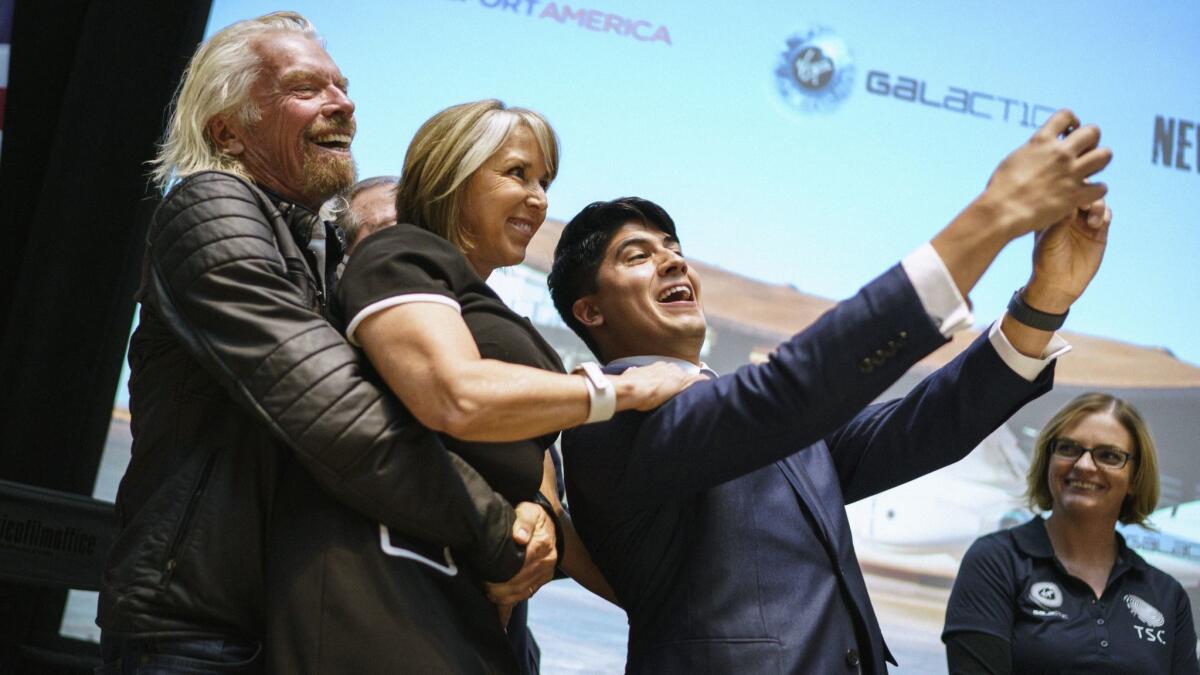Virgin Galactic’s space-tourism dream edges closer to reality

- Share via
British billionaire Richard Branson and his space-tourism company Virgin Galactic announced new steps Friday toward offering thrill rides into the low reaches of space for paying passengers, with the company immediately starting to move personnel and space vehicles from California to a launch and landing facility in the New Mexico desert.
Branson said Virgin Galactic’s development and testing program has advanced enough to make the move.
Virgin Galactic will be shifting operations to Spaceport America near the southern New Mexico town of Truth or Consequences as it prepares to begin for commercial service this year. The manufacturing of the space vehicles by the company’s sister enterprise, Spaceship Co., will remain based in Mojave, Calif.
“We are now ready to bring New Mexico a world-first, world-class space line,” Branson said. “Virgin Galactic is coming home to New Mexico where, together, we will open space to change the world for good.”
In February, a new version of Virgin Galactic’s winged craft SpaceShipTwo soared at three times the speed of sound to an altitude of nearly 56 miles in a test flight over Southern California as a crew member evaluated the passenger experience.
New Mexico officials have eagerly anticipated the arrival of space tourism by Virgin Galactic for more than a decade. Taxpayers invested over $200 million in Spaceport America after Branson and then-Gov. Bill Richardson pitched the plan for the facility, with Virgin Galactic as the anchor tenant.
Although the announcement signals the final countdown to regular commercial service for paying customers, Virgin Galactic Chief Executive George Whitesides has declined to say how many more test flights must be conducted. Branson has said he would like to make his first sub-orbital flight this year as the venture’s first passenger on July 20, the 50th anniversary of the Apollo 11 moon landing.
Space tourism has not been a complete novelty since millionaire U.S. engineer Dennis Tito in 2001 paid $20 million to join a Russian mission to the International Space Station. Branson’s goal has been to open up space travel to more and more people.
Hundreds of potential customers have committed as much as $250,000 up front for rides in Virgin’s six-passenger rocket, which is about the size of an executive jet.
But Virgin Galactic’s spaceship development has taken far longer than expected. It had a major setback when the company’s first experimental craft broke apart during a 2014 test flight, killing the co-pilot.
The endeavor began in 2004 when Branson announced the founding of Virgin Galactic in the heady days after the flights of SpaceShipOne, the first privately financed manned spacecraft that made three flights into space.
The company’s current spaceship doesn’t launch from the ground. It is carried under a special plane to an altitude of about 50,000 feet before detaching and igniting its rocket engine. The craft coasts to the top of its climb before gradually descending to Earth, stabilized by unique “feathering” technology in which twin tails rotate upward to increase drag on the way to a runway landing.
Space-sector analyst Adam Jonas, a managing director of equity research at Morgan Stanley, said Branson’s venture could have an outsized impact in the age of social media on how the public visualizes space as a domain for scientific and commercial exploration.
“You bring them back to Earth and they explain what they saw — that’s a story, put through the velocity of social media, people want to hear,” he said. “Sometimes you need some distance to gain a perspective, seeing the Earth from space, seeing how thin that layer of atmosphere is that protects us.”
Branson’s plans have gradually advanced amid a broader surge in private investment in space technology with cost-saving innovations in reusable rockets and microsatellite technology.
Amazon tycoon Jeff Bezos announced Thursday that his space company, Blue Origin, will send a robotic spaceship to the moon, with aspirations for another ship that could bring people to the moon along the same time frame as NASA’s proposed 2024 return. Bezos has provided no details about launch dates.
More to Read
Inside the business of entertainment
The Wide Shot brings you news, analysis and insights on everything from streaming wars to production — and what it all means for the future.
You may occasionally receive promotional content from the Los Angeles Times.









